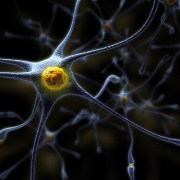 Photo: Getty Images
Photo: Getty Images
Patients who suffer from migraines have a throbbing pain in their head that gets worse and can last six to 48 hours. Some patients may experience nausea, chills, fatigue and a sensitivity to light when these headaches begin. MedlinePlus noted that this type of headache is more common among women. Migraine patients who have these headaches 15 or more days a month for at least three months have a type of migraine called chronic migraine, according to the National Headache Foundation. Treatment for chronic migraine involves controlling the triggers of migraines, such as making changes to the patient's diet, and may include medications. For example, a doctor may prescribe a patient with chronic migraines a non-steroidal anti-inflammatory drug for acute treatment, in which she would take the medication two days or less a week. If the patient is put on preventive pharmacotherapy, she may take medications such as anticonvulsants, calcium channel blockers or antidepressants, noted the National Headache Foundation.
Chronic migraine sufferers may now have another option: peripheral nerve stimulation. St. Jude Medical reported results at the 15th International Headache Congress in Berlin, Germany of a randomized clinical trial that used peripheral nerve stimulation to manage the pain from chronic migraines. Peripheral nerve stimulation uses electrodes which send electrical current to the peripheral nerves. First, the patient receives a temporary trial electrode for a week or so to see if the treatment is beneficial. With the temporary trial electrode, the patient controls an external power supply for the electrical current. If peripheral nerve stimulation with the temporary trial electrode works for the patient, the patient will have it replaced with a permanent electrode, which is connected to an internal battery pack instead. Columbia University Medical Center explained that “by stimulating the nonpainful sensory pathway, the electrical current tricks the brain into turning off (or significantly attenuating) the painful signals,” which results in pain relief. The press release for the study by St. Jude Medical has a video demonstrating how the neurostimulation system in the study works.
The study included 157 participants who were implanted with the St. Jude Medical Genesis™ neurostimulator. The first group, the active group, received stimulation of the occipital nerve right after implantation of the neurostimulator. The second group, the control group, did not have any nerve stimulation until 12 weeks later. The press release on the study reported very promising statistics, including 66 percent of patients experiencing excellent to good pain relief after a year of treatment; 51 percent of the active group reported satisfaction compared to 19 percent in the control group; and 67 percent of the active group having an improvement in their quality of life compared to 17 percent in the control group. To assess pain relief, the researchers used both standardized scales and subjective assessments; the active group had greater improvements in both types of assessments.
References
A.D.A.M. Migraine. MedlinePlus, 2011. Web. 6 July 2011
http://www.nlm.nih.gov/medlineplus/ency/article/000709.htm
National Headache Foundation. Chronic Migraine. Web. 6 July 2011
http://www.headaches.org/education/Headache_Topic_Sheets/Chronic_Migraine
Columbia University Medical Center. Peripheral Nerve Stimulation. Web. 6 July 2011
http://www.cumc.columbia.edu/dept/peripheral-nerve/problems/pns.html
Business Wire. St. Jude Medical Reveals Randomized Clinical Trial Data Demonstrating Benefit of Neuromodulation for Chronic Migraine. 23 June 2011. Web. 6 July 2011
http://www.businesswire.com/news/home/20110622005024/en/St.-Jude-Medical-Reveals-Randomized-Clinical-Trial
Reviewed July 6, 2011
by Michele Blacksberg R.N.
Edited by Alison Stanton






Add a CommentComments
There are no comments yet. Be the first one and get the conversation started!